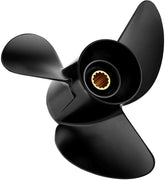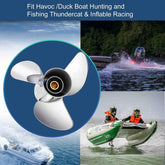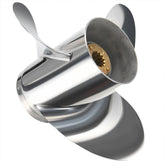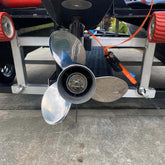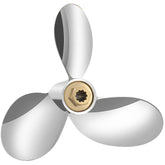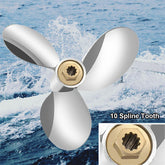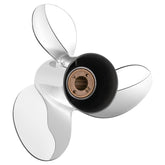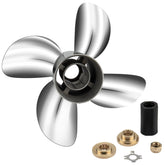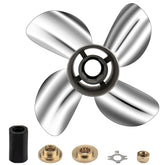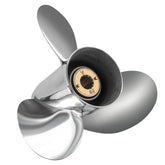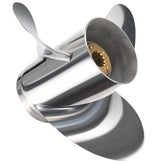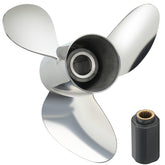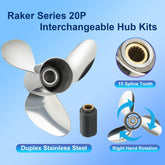Best Aluminum Bass Boats: Top Models for Fishing & Shallow Water Use
Why aluminum bass boats are perfect for shallow-water fishing
Aluminum bass boats are lightweight, durable, and designed to get you into skinny water where bigger boats can't go. For anglers who target flats, rivers, and shallow lakes, the hull shape plus the correct outboard and boat propeller determine whether you get on plane quickly, maintain control in cover, and save fuel.
If you want to learn more about how props affect performance, this short guide on How Boat Propellers Are Manufactured explains why material, pitch and blade shape matter. For dealers or outfitters sourcing parts, working with a reliable boat propeller manufacturer streamlines OEM/ODM options and quality checks.
Top aluminum bass-boat models for shallow-water use
(Selection criteria: shallow draft, stable casting platform, trailerability, and popular aftermarket support.)
1. Tracker Pro Team series
Affordable, rugged, and easy to maintain — ideal for rental fleets and entry-level anglers. Pair with a 50–115 HP outboard and a 3-blade aluminum prop for fast planing and economical operation.
2. Ranger Z-series (aluminum models)
Tournament-capable hulls with great handling. These perform well with 115–200 HP engines; consider stainless or high-quality alloy props (brand-matched options improve fit and warranty handling).
3. Nitro Z-series (aluminum variants)
Tournament-style layouts and shallow-draft options. If you fish heavy cover, a cupped 4-blade gives better bite and control.
4. Lund Rebel / Pro-V
Versatile hulls for flats and river work. Low-to-medium HP engines with a slightly lower pitch prop help you plane quickly in skinny water.
5. Skeeter FXR (aluminum options)
Lightweight, responsive boats built for performance anglers. Pair with higher HP and stainless props for consistent high-end speed and durability.
How to choose the right prop for shallow-water bass fishing
Selecting the correct propeller is as important as choosing the hull.
Key factors to consider
-
Engine HP & target WOT RPM: Your prop pitch should allow the engine to reach its recommended wide-open-throttle RPM at typical load.
-
Pitch vs. diameter: Lower pitch → better acceleration (helpful for hole-shot); higher pitch → higher top speed. For shallow-water work, err on slightly lower pitch to get up on plane quickly.
-
Blade count:
-
3-blade: Versatile — good balance of speed and efficiency.
-
4-blade: Better acceleration, lift and control in heavy cover or when heavily loaded.
-
-
Material:
-
Aluminum: Cost-effective and forgiving on strikes — a good spare.
-
Stainless steel: Stronger, holds shape under load, better fuel economy at high RPMs.
-
-
Brand-match benefits: A MERCURY propeller on a Mercury engine or a yamaha propeller on a Yamaha outboard often yields better tuning and fewer fitment issues. You can browse brand-specific models in the online store when choosing inventory.
If you want a quick way to offer customers prop choices online, keep a compact prop matrix (3-blade aluminum, 4-blade aluminum, 4-blade stainless) for each popular engine model and link directly to those collections in your product pages. Example product collections: Yamaha props and other brand pages in the online store.
Quick links (for product pages and supplier info):
Boat propeller online store — https://vifprop.com/
Yamaha propellers collection — https://vifprop.com/collections/propeller-for-yamaha
Hot-selling prop models (YBS, Chopper, Vengeance) — https://vifprop.com/collections/hot-selling
Manufacturer overview — https://vifmarine.com/
Practical prop setups (by use case)
-
Solo flats rig (light load): 50–90 HP + 3-blade aluminum prop — quick plane, economical.
-
Two-angler tournament rig: 115–200 HP + 4-blade stainless (Mercury or Yamaha) — superior hole-shot and stability in cover.
-
Heavily loaded boat / lots of gear: Lower pitch + 4-blade to help lift and keep RPMs in the ideal band.
Maintenance tips to protect propellers and performance
-
Inspect the prop for dings or bends after every trip — even small damage reduces efficiency.
-
Keep a spare aluminum prop on board as an emergency backup.
-
Remove fishing line from the shaft and prop hub to protect seals.
-
Grease the prop shaft and check hub kits regularly.
-
Rinse with fresh water after saltwater use and check sacrificial anodes.
If you'd like technical content to educate buyers, share the manufacturing guide (see How Boat Propellers Are Manufactured) on product pages — it builds trust and helps buyers understand value differences between aluminum and stainless options.
B2B checklist for dealers & outfitters (quick action items)
-
Identify customer segments: recreational, tournament, rental fleets.
-
Stock a compact prop matrix per engine brand (e.g., Yamaha, Mercury, Suzuki, Honda). Example collections: propeller for Suzuki, propeller for Honda, propeller for Volvo.
-
Offer brand-matched prop bundles (MERCURY propeller, yamaha propeller) and installation/tuning services.
-
Include RPM tuning documentation with every prop sale so customers hit recommended WOT RPM.
-
Promote hot-selling, high-margin prop models (link to hot-selling collection).
-
Provide an online store experience with clear fitment lookup (link: vifprop.com) and lead capture for OEM/ODM enquiries.
Quick FAQ
Q: Are stainless props worth it for shallow-water bass boats?
A: For higher-HP, tournament or heavily loaded boats — yes. For casual shallow-water use, aluminum is a cost-effective and forgiving choice.
Q: Should I always buy brand-matched props?
A: Brand-matched props (Mercury → MERCURY propeller, Yamaha → yamaha propeller) reduce fitment guesswork and often yield better real-world performance; they’re a good default for dealer inventory.
Conclusion & next steps
Choosing the right aluminum bass boat for shallow water is a balance of hull design, engine selection, and propeller choice. For B2B sellers, packaging hull + engine + prop options (with clear fitment guidance) shortens the sales cycle and reduces returns.


